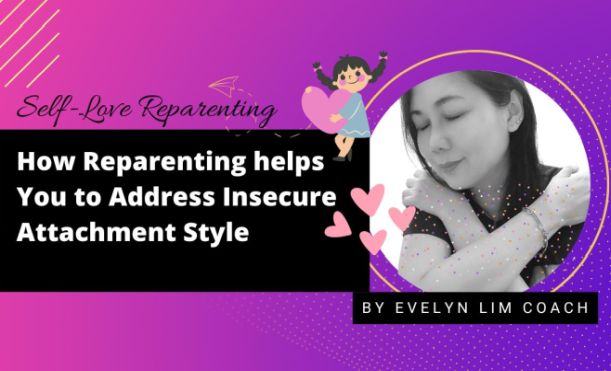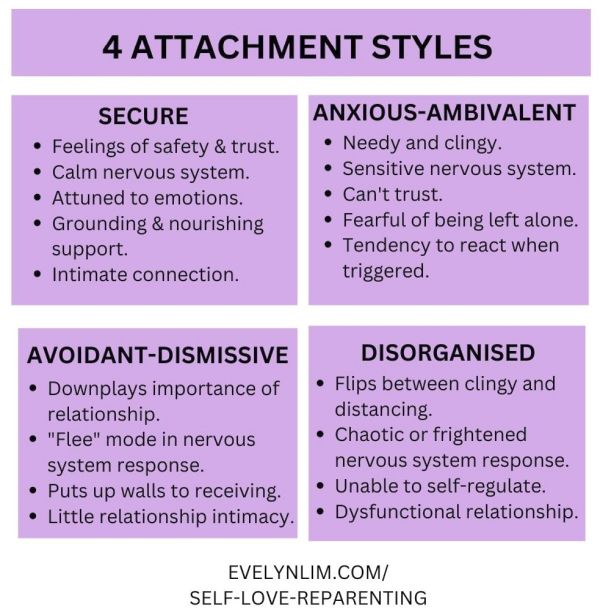This article was posted by CrystalWind.ca.
How Reparenting Helps to Address Your Insecure Attachment Style
- Details
- Written by Evelyn Lim

If you have an insecure attachment style, you can potentially benefit from doing some reparenting work.
Insecure attachment affects those in their ability to form healthy relationships, make decisions and/or to cope emotionally. On the other hand, reparenting yourself helps you to heal your inner child, gain trust and maintain emotional stability. Thus, you enhance your ability to cultivate close relationships, boost confidence and enhance overall well-being.
Attachment styles first came from the work of John Bowlby, a psychologist. He first proposed Attachment theory in the 1950s and 1960s. Attachment theory helps us to find out more about the nurturing that was experienced during the initial years of our life and how it affects us today.
Bowlby’s view is that the bond between mother and child is most important of all. The first formative 18 months is very crucial in the child’s development. Where there is adequate nurturing, the child grows up to be a secure adult. Conversely, the absence of adequate nurturing leads to insecure attachment and the forming of invisible emotional wounds that often results in maladjustments in the emotional, social and cognitive development of the child.
There are altogether 4 main attachment styles: Secure, Anxious-ambivalent, Avoidant and Disorganised.
Secure Attachment Style
A secure attachment style is created when there has been a warm and loving bond between parent and child. The child (assuming female) is able to perceive that she is cared for. She feels safe to explore, and experiences little or no anxiety separation as she is aware that her parent will still be there for her when she returns.
A secure child grows to develop social skills. She is happy to give, take, and share, and she shows empathy to others when distressed. Where she is secure, she tends to face no or fewer problems with forming long-term and intimate relationships with others during adulthood. She experiences little fear of abandonment and finds that she is able to trust her partner.
[My Comments] No reparenting is required as the inner child of a secure adult is likely to be in great psychological health and well-being.
All the other 3 styles fall under insecure attachments.
Anxious-Ambivalent Attachment Style
An anxious-ambivalent child tends to feel nervous and are not able to trust others. She has a fear of abandonment. As a result, she is fearful when she explores her surroundings. During the formative period, her caregiver may have acted nurturing and responsive one moment and unavailable or insensitive the next. The caregiver’s actions may not have been intentionally neglectful but the child perceives an inconsistency. As a result, she gains anxiety and tries her best to seek approval.
Ambivalence refers to having mixed feelings, thus potentially leading to indecisiveness or uncertainty in adulthood. Those with anxious attachment style tend to be clingy and emotionally dependent on others. They often feel unloved by their partners whilst finding it difficult to love themselves. Consequently, they tend to sabotage their relationships.
[My Comments] Reparenting of the inner child needs to involve alleviating any fears of abandonment, calming heightened anxiety and building trust with consistency and reliability.
Avoidant-Dismissive Style
An avoidant child finds it necessary to protect herself by becoming self-reliant. She holds the view that her emotional needs are likely to remain unmet. And so, she needs to behave like a “little adult”.
Her caregivers may have disregarded her needs by not being responsive and behaving in a manner that appears to be a rejection. For example, she may have been told to “stop crying”, “grow up” or “you’re acting like a baby”. Hence, she has no outlet to express what she feels. As a result, the avoidant child finds it hard to get into close relationships. In adulthood, she avoids intimacy and tend to shut down any form of attachment. During times of crisis, she often find it hard to cope emotionally and have trouble seeking help.
[My Comments] Reparenting is to involve acknowledging how the inner child feels, offering her a safe space to process her emotions and letting her know that it is okay for her to reach out for help.
Disorganised Attachment Style
Disorganised attachment is a combination of avoidant and anxious attachment. A child with disorganised attachment style often demonstrates intense anger and rage. The fearful avoidant attachment style is often seen in children who have gone through deep trauma or abuse.
During the formative period, the caregiver may have behaved chaotically or unpredictably. There is a huge contrast in behaviour, which puts the child in a lot of fear and the child perceiving the caregiver to be “scary”. The caregiver goes from being affectionate to aggressiveness and back again, without any logical explanation.
Fearful avoidant children with disorganised attachment face the challenge of having to adapt to their caregiver’s behaviour. They end up confused about how they should act. Another reason for fear is going through trauma that involves the attachment figure. For instance, the caregiver abuses the child (verbally, physically, or sexually) or the child witnesses the caregiver abuse someone else. The child is no longer able to trust the caregiver.
Those with disorganised attachment styles want to love and be loved but at the same time, they are afraid of letting anyone into their heart. They have a strong fear that the people who are closest to them will hurt them. Their fears often become self-fulfilling. As adults, they are afraid of getting into intimate relationships and can have a difficult time controlling their emotions.
[My Comments] Reparenting work needs to involve building safety and helping the inner child set healthy boundaries. Deep healing work is necessary where there is past trauma.
Addressing Insecure Attachment Through Reparenting
Refer to the graphic for a summary on the 4 attachment styles.

Fortunately, it is possible to address insecure attachment styles. You may have started out as being insecurely attached when you were young but through reparenting and healing your inner child, it is possible to become a lot more confident, trusting and grounded.
In short, the message is…
“Reparent yourself, so that you can transform your insecurely attached inner child to one that feels safe, holds confidence and one that is able to set healthy boundaries.” Evelyn Lim
Apply for a discovery call to find out more about working with me, so that you can turn your insecure attachments to healthy reparenting!
With love,
Evelyn Lim
Reparenting Coach
© 2023 crystalwind.ca. All rights reserved. We track all IP addresses with sniffer technology. Using a Proxy/VPN will not hide your IP address.
© CrystalWind.ca 2024. All content (articles, imagery, fair use) & design protected. Written permission required for copying. All rights reserved.
Join the Conversation Now! Comment Below! ![]()

Spirit Animal Totem Of The Day!
Crystal Of The Day!
Latest Articles
CrystalWind.ca is free to use because of
donations from people like you.
Donate Now »

Unlock Your Light: Join Lightworkers Worldwide on CrystalWind.ca!
Follow Us!
Who is Online Now
We have 20366 guests and no members online
Featured This Month
Lughnasadh (Lammas) - The Celtic Harvest Fes…
The Celtic harvest festival on August 1st takes its name from the Irish god ... Read more
The Season of Lammas
The season of Lammas (also called Lughnasadh) begins on August 1st and conti... Read more
Lammas by The Hedgewitch
Although in the heat of a Mid-western summer it might be difficult to discer... Read more
Lugh - Celtic God Of The Sun
The god Lugh was worshiped in Ireland as a deity of the sun. This connection... Read more
The Hazel Tree: August 5 - September 1
Celtic Symbol : The Rainbow Salmon Zodiac Degrees : 12º00` Leo - 8º59` Virg... Read more
Lughnasadh Meditation
The Seventh Sabbat of the Wheel is Lughnasadh. Lughnasadh is celebrated on A... Read more



























































































































































